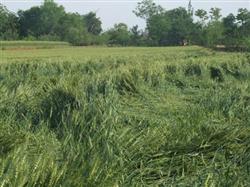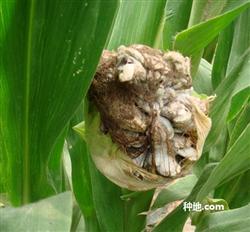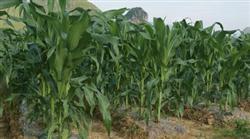Control techniques of diseases and insect pests of high-quality wheat in spring

With the acceleration of the adjustment of agricultural structure, the production of high-quality wheat has developed rapidly, but diseases and insect pests have always been one of the important factors restricting the improvement of wheat yield and quality. in order to effectively prevent and control the occurrence and spread of diseases and insect pests of high-quality wheat in spring, improve the commerciality of high-quality wheat, achieve high quality, high yield and high efficiency, and increase farmers' income. In this paper, the main pest control techniques of high-quality wheat in spring are briefly described as follows: first, the jointing stage. The key points of control at the jointing stage are wheat sheath blight, trematodes and red spiders. Sheath blight is one of the main diseases in the production of high-quality wheat, which should be controlled sooner rather than later. Generally, it is the first time to spray the fungicide in the first ten days of March, and then spray it again every 10 to 15 days. 667 square meters (1 mu) with 20% Jingangmycin wettable powder 40 grams or 20% Wankujing wettable powder 40 grams or 12.5% Heguoli wettable powder 20 grams or 20% triadimefon EC 40 grams 50 grams plus water 40 grams 50 kilograms, spray at the base of wheat, it can also treat wheat powdery mildew, rust and other diseases. The occurrence of trematodes is relatively serious in recent years, generally 3 × 5 per square (10 cm × 10 cm × 20 cm), and the highest is more than 90, resulting in reduced wheat yield or almost no harvest. To seize the favorable opportunity when the wheat seedlings are small and easy to operate, when the trematode larvae rise to the soil surface, 667 square meters use 40% methyl isophosphate EC 150ml 200ml or 50% phoxim EC 200ml mixed with the right amount of water, mix fine soil 25kg to make poisonous soil, spread it evenly along the wheat ridge, then hoe shallowly, turn the medicinal soil into the soil and then water it. Or 667 square meters with 3% methyl isophosphates granules 2 kg mixed with fine soil 20 kg evenly spread to the surface, and then shallow hoe into the added soil, but also can control golden needle worms, mole crickets, grubs and other pests. When the investigation of part of the wheat field red spider reached the control standard, 667 square meters were treated with 1.8% mite EC 6ml or Luheng killed 20ml plus water 40kg spray. Second, booting, heading and flowering stage. During this period, we will focus on the prevention and control of trematodes and red spiders, and monitor diseases and pests such as powdery mildew, stripe rust and scab. When the wheat enters the heading and flowering time, it is the critical period when the sucking adults are unearthed to damage the wheat (before April 25). Spray control in time with 50% phoxim emulsion 50 ml or 40% omethoate 40 ml plus 40 kg of water for every 667 square meters. If when the wheat begins to blossom and the trematode has drilled into the wheat glume and begins to suck the pulp, it will be useless to spray again. When the wheat field red spiders or long-legged red spiders reach 0.33 meters in a single row, 200 or 100 respectively, control should be carried out. 667 square meters are sprayed with L8% mites EC 6ml and 40kg water, and it can also control ear aphids. Powdery mildew, rust and other epidemic diseases must be investigated regularly, and control should be carried out in time when the control target is reached, in order to prevent its epidemic in a large area. 667 square meters use 12.5% WP 20 grams or 15% WP 75 grams 100 grams plus water 50 kg uniform spray, 7 days later spray again, the control effect is very good. Wheat heading to the beginning of flowering, if the weather forecast for more than 2-3 days of rainfall, should immediately 667 square meters with 50% carbendazim emulsion 100 ml or 70% methyl thiophanate wettable powder 100 grams plus 50 kg water spray, can effectively prevent the occurrence of scab. Third, filling period. The filling stage of wheat is not only the peak period of many diseases, but also the key period to control diseases and insect pests and win high yield and high quality of wheat. The key points of control in this period are wheat ear aphid, powdery mildew, rust and so on. 667 square meters are sprayed with 20 grams of 10% imidacloprid wettable powder or 25% Kuaishaling EC 25ml plus 40kg water, which can effectively control wheat aphid. The control methods of powdery mildew and rust are the same as above, and wheat leaf blight can be treated at the same time. If the ratio of natural enemies to aphids in the field is more than 1: 120, it is no longer necessary to use insecticides to control aphids. For the prevention and control of diseases and insect pests of dominant wheat, according to the different characteristics of different wheat varieties, on the basis of the prediction of diseases and insect pests, targeted prevention and control should be carried out according to the control index.
- Prev

What if the corn core is rotten?
What is corn empty stalk disease? Please introduce the symptoms of corn empty stalk disease: corn usually bears two ears, usually one ear, but empty stalk often occurs in the production process, which affects the increase of yield. Such as the investigation in Kuandian, Yangyan, Benxi, Huanren and other places in Liaoning, the empty stalk rate is 12% Mur20% 667 m2 and the yield is reduced by 50 kg.
- Next

Four determination of fertilization for High yield of Spring Maize
In recent years, due to the lack of organic fertilizer input and people's demand for increasing per unit yield, the amount of fertilizer applied to corn has increased significantly, and the application area of some high concentration compound fertilizers has also been expanded, which has effectively promoted the increase of yield. but there are often fertilizer damage at seedling stage, element deficiency or late fertilizer loss and yield reduction, farmers.
Related
- The first cup of black tea in spring, the flavor and history of tea gardens in Kenya, Africa
- The computer can not only choose potatoes, but also grow tea rice. AI will grow winter oolong tea champion.
- It is not only the inflated tea bitten by insects, but also engraved with the four seasons tea in Beipu.
- The Oriental Beauty Tea Festival in Zhuxian County takes the stage at the weekend to experience the plus-size feast of oil tea.
- & quot; Oriental Beauty Tea & Exploration of Emei in Hsinchu, the hometown of quot;
- The new variety of strawberry "Tainong 1" dessert is the first choice with mellow aroma. Crimson gorgeous
- History of Tea in Taiwan: from Wild Inner Mountain to Export Tea Garden
- Two types of Taiwan Oriental Beauty Black Tea won the British three-Star Award for Childhood Tea Xiang Zhang Jiaqi changed from pilot to champion tea maker.
- Banana species and varieties: the planting history of Taiwan Xianren banana and dwarf banana is long, is banana disease resistant?
- Coffee planting Technology: Qianjie Coffee from Seedling to harvesting

